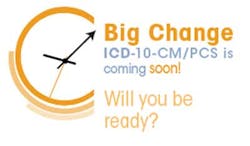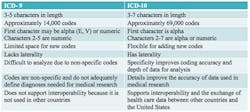Dental coding ICD-10 CM – Time to prepare your practice now!
Tick-tock, tick-tock, tick-tock. Hear that? It's the sound of time passing. On October 1, 2015, the United States will implement a new, updated diagnosis code set. ICD-10 CM (International Classification of Disease, Volume 10) will become the new code set for all medical claims submitted with a date of service after October 1, 2015.
What does all this have to do with ICD-10 CM? One of the biggest differences between a medical claim form and a dental claim form is the required reporting of diagnosis codes. Medical insurance carriers pay their claims based on medical necessity. It becomes our job to provide the carrier with the reason or medical necessity for the procedure. We do this by using diagnosis codes. I teach my clients that diagnosis codes help us tell the story to the insurance carrier. We are not making up a story to get a claim paid; we are telling the story of why the procedure was performed by using codes. No narratives, no extra paperwork, just one claim form submitted one time. How cool is that?
We are currently using ICD-9 CM here in the U.S. How we use the codes, how we look them up, and their purpose, will remain the same as we move to ICD-10 CM. What will be very different are the way the codes will look and the number of codes we will have to submit come next October.
Here is a comparison of the two code sets:
As you can see, the number of codes will increase significantly, as will the specificity of the codes. A mapping has been created to help map us from ICD-9 CM to ICD-10 CM and back from ICD-10 CM to ICD-9 CM. These mappings are called General Equivalency Mappings, or GEMS. While these are great tools to start with, GEMS are not a replacement of learning ICD-10 CM. For some codes in ICD-9 CM, there is only one code in ICD-10 CM, and for other codes in ICD-9 CM, there are multiple code choices in ICD-10 CM. You can easily see the level of specificity that is going to be required as we move toward next October. Remember, this is big! The diagnosis code we put on a medical claim form has to be supported by the documentation in the patient record. We cannot put a code on a claim form just to get the claim paid; it has to be supported by the information in the record!
I mentioned earlier that dental offices can often submit a claim to a medical carrier for dental services related to trauma for patients. Let’s take a look at a scenario and how that will look as of October 2015.
Imagine your patient is a 12-year-old boy who fell in his yard while riding his bike. When he fell, he landed on a tree root and cut his lower lip. He is in your office and you are preparing a claim form to send to his medical insurance carrier. Here are the IDC-10 CM diagnosis codes that will have to be listed on the claim form in order to tell the story to the insurance carrier:
• S01.541A Puncture wound with foreign body of lip, initial encounter
• V18.0xxA Pedal cycle driver injured in non-collision transport accident in non-traffic accident
• Y92.017 Garden or yard in single-family (private) house as place of occurrence for external cause
• Y93.55 Activity, bike riding
• Y99.8 Other external cause status (includes leisure activity)
Wow! That’s a lot of information and we haven’t even reported a procedure code yet! Take a step back and look at all that was accomplished by reporting diagnosis codes. Didn’t we tell the entire story to the medical carrier – who got hurt, how the injury happened, when it happened, what the person was doing at the time of the injury, and why the person was doing it. I think this is fascinating and awesome, and when done correctly, it can save a lot of grief and paperwork when dealing with medical insurance carriers.
My intention is not to scare you. To be honest, I was somewhat afraid of ICD-10 CM before I became acquainted with it and learned how to use it. Now I’m a raving fan. The level of specificity in the code set actually makes our jobs easier because there is literally a code for everything. No more guessing, and no more listing of unspecified codes. Once I got over the new look, I was a fan.
I hope this article plants the seed for you to start the learning process. Become acquainted with the codes and learn how they’re to be used in your dental practice. We’re not able to use these codes until next October, but we don’t want to wait until next September to prepare for them. Start learning now so you won’t be overwhelmed next fall.
We’re here to help you with this transition. If you need training on this new code set, please do not hesitate to reach out to me.



